Chenoweth Laboratory Memorial
Introduction
Text-to-speech Audio
Images
Walter W. Chenoweth, plaque.
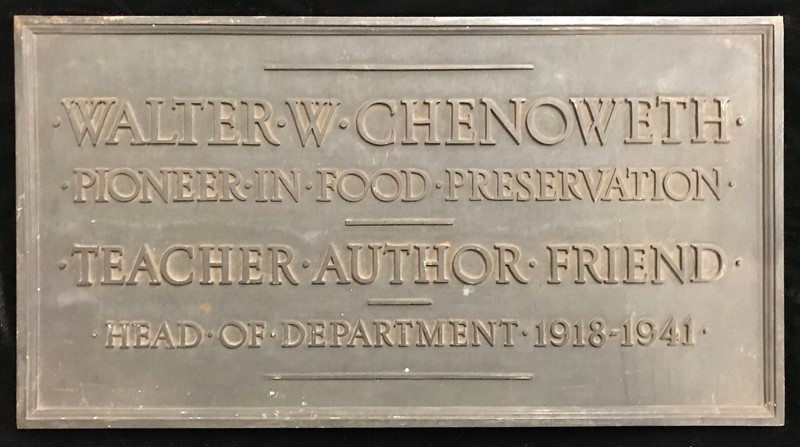
Walter W. Chenoweth, 1927.

Walter W. Chenoweth stirring a pot on stove, in laboratory, ca. 1941.
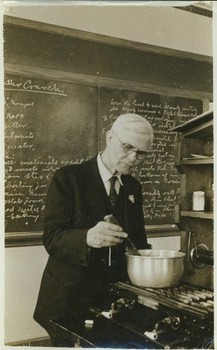
Chenoweth Lab, undated.
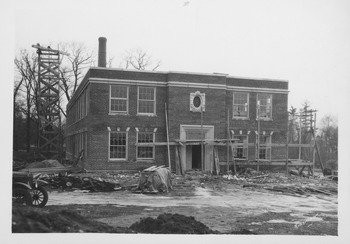
Chenoweth Lab, undated.
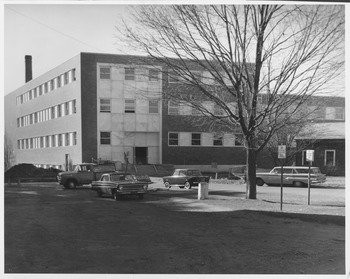
Chenoweth Lab, early 1900s.
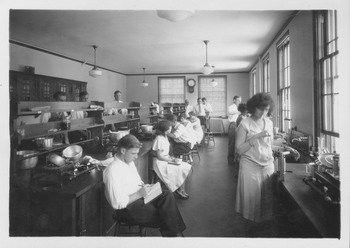
Chenoweth Lab, post 2000.
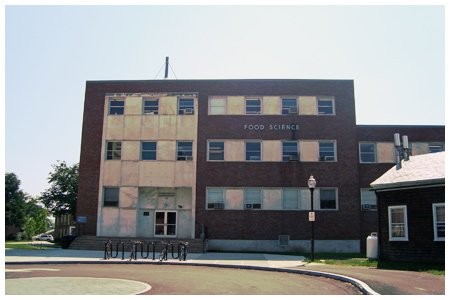
Backstory and Context
Text-to-speech Audio
Also see: Chenoweth, Walter W.
Horticultural Manufactures (Food Science), 1912-1941
b. 1872, Wisconsin
d. 1945, Amherst, Mass.
Walter W. Chenoweth, the founder of the Horticultural Manufactures Department in 1918, predecessor to the Food Science Department, was a key figure in the development of research and education in modern food science. Hired as a pomologist at Mass. Agricultural College in 1912, Chenoweth had no background in food science, but encouraged by Frank A. Waugh and supported by Frederick Sears, he developed a course of study from scratch, learning and standardizing many of techniques himself while teaching. His curriculum and the processes he and his students developed for preserving food contributed to easing the food shortages brought on by World War I.Under the aegis of the new department, Chenoweth initiated a program in community food preservation, instructing students and members of the public in canning and other techniques. In 1929-1930, he loaned his services to the Grenfell Mission in Newfoundland, setting up canneries and teaching the methods of food preservation to would-be colonizers in Newfoundland and Labrador. Faced with a dearth of solid literature in the field, he published a textbook, Food Preservation (1930), which was a standard text for many years. The University named the Food Science building in Chenoweth’s honor after it was built in 1965. Chenoweth retired in 1941 and died four years later at the age of 75.
Resources
- See Walter W. Chenoweth Papers, University Archives (FS 046)
Also See: Chenoweth Laboratory
Design and construction
Chenoweth Laboratory is a two-story brick building with Georgian Revival elements of a minimal nature, such as the splayed brick lintels with interspersed keystones above door and windows. The building is 11 bays wide and six bays deep, with a concrete foundation, concrete trim and a flat roof.
The building’s ornamentation is limited to the concrete cornice at the bottom of the roof parapet wall, the brick lintels and the keystones mentioned above. The building had considerably more ornamentation on its main elevation when it was built in 1930. Historic photographs of Chenoweth Laboratory on file at Special Collections and Archives, W.E.B Du Bois Library, University of Massachusetts Amherst show that the building’s main entry was originally on its north elevation, which was destroyed when the Chenoweth Laboratory Addition (UMass Building #344) was constructed in 1966. The north elevation’s main entry originally featured a prominent Art Deco doorframe, which had an oval window framed with a neoclassical wreath made of stone, or concrete, above the doorway.
The building’s current main entry is centered in its east elevation. It appears that the building originally had five 8/8 sash windows to either side of the door and the second story originally had 11 such 8/8 windows. One of the first story windows has been fully bricked in, and two of the second story windows have been mostly bricked in, with louvered ventilation panels inserted into the top of the former window openings. No splayed brick lintels or keystones remain where the windows were bricked in. The four windows that remain at the south side of the door have bars on the outside. The central entry has a double-leaf door with 3/4 fixed panes in the upper half of each leaf and two panels in the lower half. The doors are flanked by 2/6 sidelights and topped by a multi-pane transom.
Chenoweth Laboratory’s south elevation now contains two 8/8 windows on its first story and six evenly spaced 8/8 windows on its second story. Based on the different color of the brick, the building’s south elevation originally had five evenly spaced windows on its first story. As with the east elevation, no splayed brick lintels or keystones remain where the windows were bricked in here.
Landscape
Chenoweth is bordered by Flint Laboratory to the east, Stockbridge Hall to the northeast, Hatch Laboratory to the North, and the Agricultural Engineering Complex to the west.
Naming of the building
Sources
Chenoweth Laboratory, YouMass, http://scua.library.umass.edu/youmass/doku.php?id=c:chenoweth_laboratory
